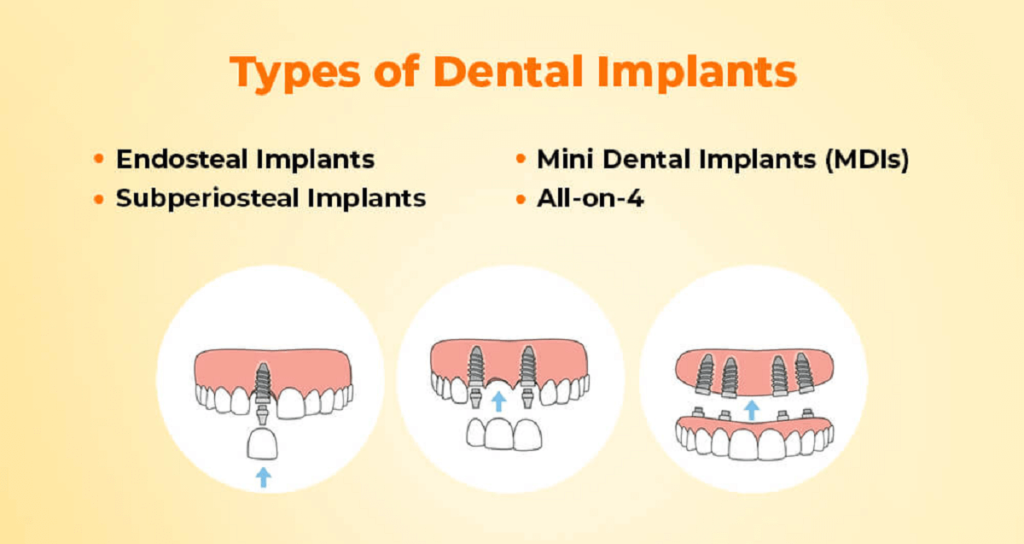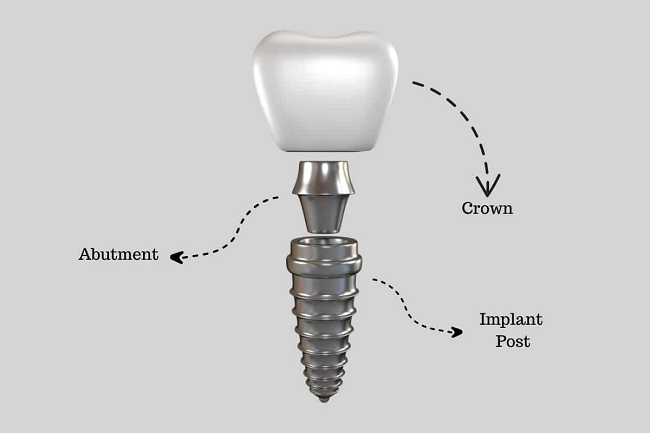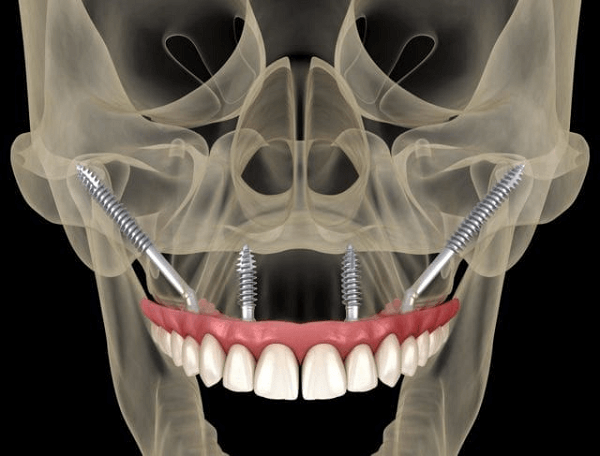Missing teeth can affect your confidence, eating habits, and overall oral health. Fortunately, modern dentistry offers various dental implant types to restore your smile and functionality. Understanding the different dental implant types and classifications helps you make informed decisions about your oral health care. Different dental implant types, like zirconia and titanium, offer unique benefits and considerations.
In this comprehensive guide, we’ll explore all major dental implant types, their procedures and materials, and which option might work best for your situation.

What is a Dental Implant?
A dental implant is made of titanium or zirconia post that is surgically inserted into your jawbone. It fuses with the bone and becomes the roots of missing tooth. This artificial root supports crowns, bridges, and dentures. The implant becomes one with your bone via osseointegration, and forms a stable foundation that looks and works like natural teeth.
The implant has three primary components:
Implant post: The titanium or zirconia screw inserted into the jawbone
Abutment: The piece that is a connector. It links the post with the crown
Crown: The visible tooth replacement that rests on top

Dental Implant Types Based on Placement Method
Endosteal Implants
Endosteal implants are one of the most commonly used dental implant types today. These screw-shaped dental implants are surgically inserted directly into the jawbone. Once the surrounding gum tissue has healed, a second surgery links a post to the implant. Finally, an artificial tooth is cemented or screwed onto the post.
Endosteal implants are best suited for patients who have healthy jawbones and sufficient bone density.
Subperiosteal Implants
Subperiosteal implants are the dental implant types and that is inserted below the gum tissue. But the rest on top of the gum. For subperiosteal implants, a metal framework is inserted under the gums.
Subperiosteal dental implant types are a suitable option in the following cases:
- Inadequate height of the jawbone for endosteal implants
- Patients who cannot or refuse to have bone augmentation
- As an alternative to bone grafting surgeries
It’s a procedure that requires impressions of your jawbone, fabrication of a custom metal framework, and surgical implantation beneath your gums. It is less invasive than bone grafting, but has lower success rates than endosteal implants.
Zygomatic Implants
Zygomatic implants are an advanced solution for patients who have severely less jawbone. They are fixed in the zygomatic bone (cheekbone). In most cases, it remains solid even when jawbones lose density.
However, zygomatic implants require specialized surgical expertise and are only suitable for upper jaw restoration. The procedure is more complex than traditional implant placement and carries additional risks.

Dental Implant Types Based on the Procedure Timeline
Immediate-Load Implants
Immediate-load implants are also called same-day implants because a temporary tooth can be attached at the time of implant placement. This treatment is most successful if you have an adequate bone density and the implant gains good primary stability.
Here are some advantages of immediate-load implants:
- You can get a tooth replacement immediately
- Requires shorter visits to the dentist
- Preserves of facial esthetics
- You can eat normally
Delayed-Load Implants
Delayed-load implants are the dental implant types that use the conventional two-stage method. The implant is inserted and left to heal for 3-6 months before being joined with the artificial tooth. This allows complete osseointegration to achieve optimum implant stability.
Mini Dental Implants (MDIs)
Mini dental implants are short-term implants that are smaller than standard implants, usually less than 3 millimeters in diameter.
Although mini implants provide the benefits of less healing time and cost-effectiveness, they are not suitable for all cases. They function best for lighter chewing pressures.
Dental Implant Types According to Material
Titanium Implants
Decades ago, titanium became the standard for dental implants types procedures. It is a biocompatible metal that heals well with bone tissue and provides established long-term success.
Let’s look at some advantages of titanium implants:
- High biocompatibility
- High osseointegration
- Decades of clinical evidence
- High success rates
- Corrosion resistance
Some potential drawbacks of titanium dental implants are:
- Gray color can come through very thin gums
- For some patients, metal in the mouth becomes an issue
Zirconia Implants
Zirconia dental implant types provide a metal-free choice, They are made of a white, ceramic material. They are a popular choice due to their biocompatibility and metal-free solutions. Some advantages of zirconia implants are:
- Metal-free
- White color
- High biocompatibility
- No metal allergy risk
- Better aesthetics in thin gum tissues
Aidite offers high-quality dental zirconia. Their zirconia is best for dental implants. Aidite zirconia has high translucency that looks just like natural teeth and also provides excellent strength. Aidite provides multiple zirconia products suitable for different requirements. Aidite 3D Pro Zir is a multilayer zirconia that has a natural color gradient and provides excellent aesthetics.
Pros and Cons of Dental Implants
Here are some pros and cons of dental implants:
Pros:
- Appear and Feel Like Natural Teeth:
Dental implants are exactly like teeth in the size, shape and color of your natural teeth. They are integrated with the bone and are very stable.
- No Effect on Adjacent Teeth:
Getting dental implants does not require grinding down the neighbouring teeth. So, they maintain the natural bite alignment.
- Permanent Solution:
With proper care, dental implants can last for a lifetime. This justifies their higher upfront cost.
- Easy to Maintain:
You have to take care of dental implants just like natural teeth. It does not require any extra work.
Cons:
- Surgical Procedure:
Getting dental implants requires a surgical procedure which has risks like pain and swelling.
- High Initial Cost:
Dental implants are very expensive upfront as compared to other alternatives.
- Longer Treatment Period:
The process of getting dental implants takes several months. So, it is not ideal for patients seeking quick fixes.
- Risk of Failure:
Although, very rare dental implants have a risk of failure. This can be due to poor osseointegration, infection or health conditions .
FAQs About Dental Implant Types
What are the 3 types of dental implants?
The three primary dental implant types, depending on placement, are endosteal implants (inserted into the jawbone), subperiosteal implants (inserted on the surface of the jawbone beneath the gum), and zygomatic implants (fixed in the cheekbone). Endosteal implants are the most frequent and appropriate for candidates with sufficient bone density.
Is zirconia or titanium better for dental implants?
Both have strengths in dental implant types and classification. Titanium brings decades of studies, great osseointegration, and established success rates. Zirconia gives a metal-free composition, better looks, and biocompatibility. You can choose one based on personal taste, aesthetic requirements, allergies, and your dentist’s advice on your particular case.
How many types of dental implants are there?
There are several ways to categorize dental implant types. Based on the placement technique, three primary types are endosteal, subperiosteal, and zygomatic. Material-wise, the choices are mainly titanium and zirconia. Based on the procedure timeline, implants are immediate-load, delayed-load, or mini-implants. Each type addresses different patient requirements and situations clinically.
Which dental implants are best?
The best dental implant types are determined based on your own case, bone quality, aesthetic requirements, and affordability. Different options offer different advantages. For example, zirconia implants are best used in aesthetic areas. Your dentist will give you the best suggestion after a detailed assessment.
Conclusion
For selecting the appropriate dental implant types, you should consider your own needs, bone health, and treatment objectives. From standard endosteal implants to advanced zygomatic options, there are many dental implant types. Knowing dental implant types and classification will give you the confidence to engage in discussions with your dental care team and make informed choices regarding your oral health. You should take the pros and cons of dental implants into consideration. When it comes to dental supplies, Aidite is trusted by dental professionals around the world. For modern dental care, Aidite offers a balance of performance and reliability in its products.



